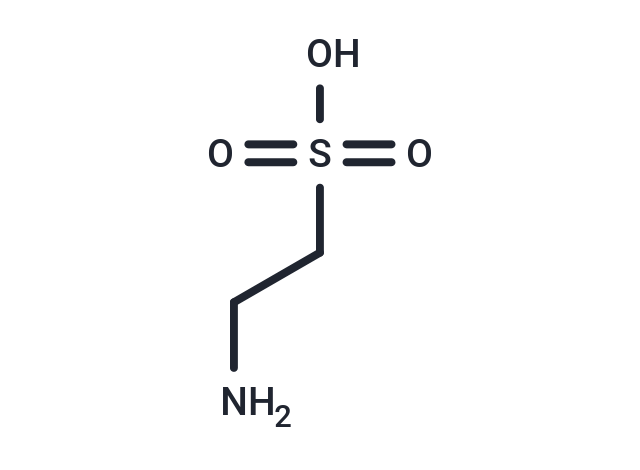Shopping Cart
- Remove All
 Your shopping cart is currently empty
Your shopping cart is currently empty

Taurine (2-Aminoethanesulfonic acid) is an organic acid widely distributed in animal tissues and is one of the constituents of bile acids. Taurine is involved in a number of processes related to energy expenditure and muscle function, and can treat fatigue and muscles as well as improve immune function.

| Pack Size | Price | Availability | Quantity |
|---|---|---|---|
| 500 mg | $41 | In Stock | |
| 1 g | $48 | In Stock |
| Description | Taurine (2-Aminoethanesulfonic acid) is an organic acid widely distributed in animal tissues and is one of the constituents of bile acids. Taurine is involved in a number of processes related to energy expenditure and muscle function, and can treat fatigue and muscles as well as improve immune function. |
| In vitro | METHODS: Primary alveolar epithelial cells from mice were treated with TGF-β1 (1-3 ng/mL) and TD139 (10 µM), and the expression levels of target proteins were detected by Western Blot. RESULTS: TD139 blocked TGF-β1-induced β-catenin phosphorylation. [1] METHODS: FTC-133 and 8505C cells were treated with TD139 (0-100 µM) for 72 h. Cell viability was determined by CCK8 assay. RESULTS: TD139 decreased cell viability in a dose-dependent manner. [2] |
| In vivo | METHODS: To investigate the effect on the fibrotic phase of bleomycin-induced lung injury, TD139 (10 µg) was administered as an endotracheal drip to the lungs of mice with pulmonary fibrosis four times every two days. RESULTS: In the lungs of WT mice treated with TD139, there was a significant reduction in fibrosis and β-catenin activation, as well as a decrease in galectin-3 expression.TD139 significantly reduced the total amount of pulmonary collagen. At the same time, the fibrosis score decreased from 3.8±0.4 to 2.6±0.3. In the absence of bleomycin, TD139 had no effect on fibrosis. [1] |
| Alias | 2-Aminoethanesulfonic acid |
| Molecular Weight | 125.15 |
| Formula | C2H7NO3S |
| Cas No. | 107-35-7 |
| Smiles | NCCS(O)(=O)=O |
| Relative Density. | 1.494 g/cm3 |
| Storage | Powder: -20°C for 3 years | In solvent: -80°C for 1 year | Shipping with blue ice. | ||||||||||||||||||||||||||||||
| Solubility Information | H2O: 12.5 mg/mL (99.88 mM), Sonication is recommended. DMSO: < 1 mg/mL (insoluble or slightly soluble) | ||||||||||||||||||||||||||||||
Solution Preparation Table | |||||||||||||||||||||||||||||||
H2O
| |||||||||||||||||||||||||||||||

Copyright © 2015-2025 TargetMol Chemicals Inc. All Rights Reserved.